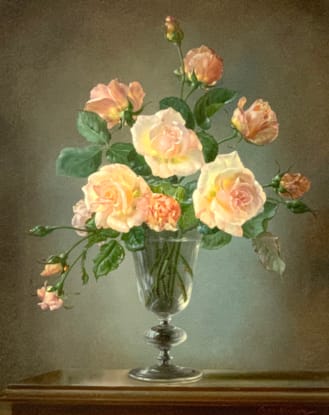Thomas Cooper Gotch
(1854 - 1931)
Sunset
Signed, lower right: T C Gotch
Oil on canvas
12 x 18 in – 30.5 x 45.5 cm
Frame size
16¾ x 22½ in – 42.5 x 56.2 cm
Oil on canvas
12 x 18 in – 30.5 x 45.5 cm
Frame size
16¾ x 22½ in – 42.5 x 56.2 cm
Tel.: +44 (0)20 7839 7693
Provenance
Private collection, UK
Biography
Thomas Cooper Gotch was born in Kettering 10th December 1854, the son of a shoemaker who assisted his son in his artistic career, and that of his brother, an architect.
Gotch studied at Heatherley’s school of art in London from 1876 and from 1877-1878 at the Royal Academy in Antwerp. In 1879 he enrolled at the Slade where he met his wife, a fellow student, Caroline Burland Yates (1854-1945), and became close friends with Henry Scott Tuke, RA, RWS (1858-1929). Following the Slade, he and his wife studied at the Académie Julian in Paris before embarking on a trip to Australia in 1883.
On their return, Gotch and his wife settled in Newlyn, Cornwall, where they had married in 1881, rapidly settling into the artistic community there. He was friends with Stanhope Forbes (1857-1947) and taught classes in art and was a founder member of the Newlyn Art Gallery. Gotch initially painted ‘en plein air’, like many of his peers, his works showing the influence of his time spent in France and that of Jules Bastien-Lepage (1848-1884). However, his style experienced a dramatic change following visits to Paris and Florence in 1891-92. Inspired by the works of Sandro Botticelli (1445-1510) and Renaissance painting, Gotch painted subjects loosely associated with those of the Pre-Raphaelites, a form of decorative symbolism with vivid vibrant colours exemplified in ‘Alleluia’ Tate Britain, ‘A Pageant of Childhood’ Walker Art Gallery, Liverpool, and ‘Holy Motherhood’ Bristol Art Gallery.
Gotch was a widely respected member of the Newlyn Art Colony and highly successful. He exhibited widely, at the Paris Salon, the Royal Academy and was a member of the RI, the RBA and RWA, he was a founder member of the NEAC and the Newlyn Art Gallery.
His works can be seen in public collections including Aberdeen; Bristol; Falmouth; London, Tate Britain; Newcastle; Northampton; Penzance; Preston; Rochdale; Sheffield; Truro; York; Cape Town; Port Elizabeth; Melbourne and Sydney.
Gotch studied at Heatherley’s school of art in London from 1876 and from 1877-1878 at the Royal Academy in Antwerp. In 1879 he enrolled at the Slade where he met his wife, a fellow student, Caroline Burland Yates (1854-1945), and became close friends with Henry Scott Tuke, RA, RWS (1858-1929). Following the Slade, he and his wife studied at the Académie Julian in Paris before embarking on a trip to Australia in 1883.
On their return, Gotch and his wife settled in Newlyn, Cornwall, where they had married in 1881, rapidly settling into the artistic community there. He was friends with Stanhope Forbes (1857-1947) and taught classes in art and was a founder member of the Newlyn Art Gallery. Gotch initially painted ‘en plein air’, like many of his peers, his works showing the influence of his time spent in France and that of Jules Bastien-Lepage (1848-1884). However, his style experienced a dramatic change following visits to Paris and Florence in 1891-92. Inspired by the works of Sandro Botticelli (1445-1510) and Renaissance painting, Gotch painted subjects loosely associated with those of the Pre-Raphaelites, a form of decorative symbolism with vivid vibrant colours exemplified in ‘Alleluia’ Tate Britain, ‘A Pageant of Childhood’ Walker Art Gallery, Liverpool, and ‘Holy Motherhood’ Bristol Art Gallery.
Gotch was a widely respected member of the Newlyn Art Colony and highly successful. He exhibited widely, at the Paris Salon, the Royal Academy and was a member of the RI, the RBA and RWA, he was a founder member of the NEAC and the Newlyn Art Gallery.
His works can be seen in public collections including Aberdeen; Bristol; Falmouth; London, Tate Britain; Newcastle; Northampton; Penzance; Preston; Rochdale; Sheffield; Truro; York; Cape Town; Port Elizabeth; Melbourne and Sydney.




